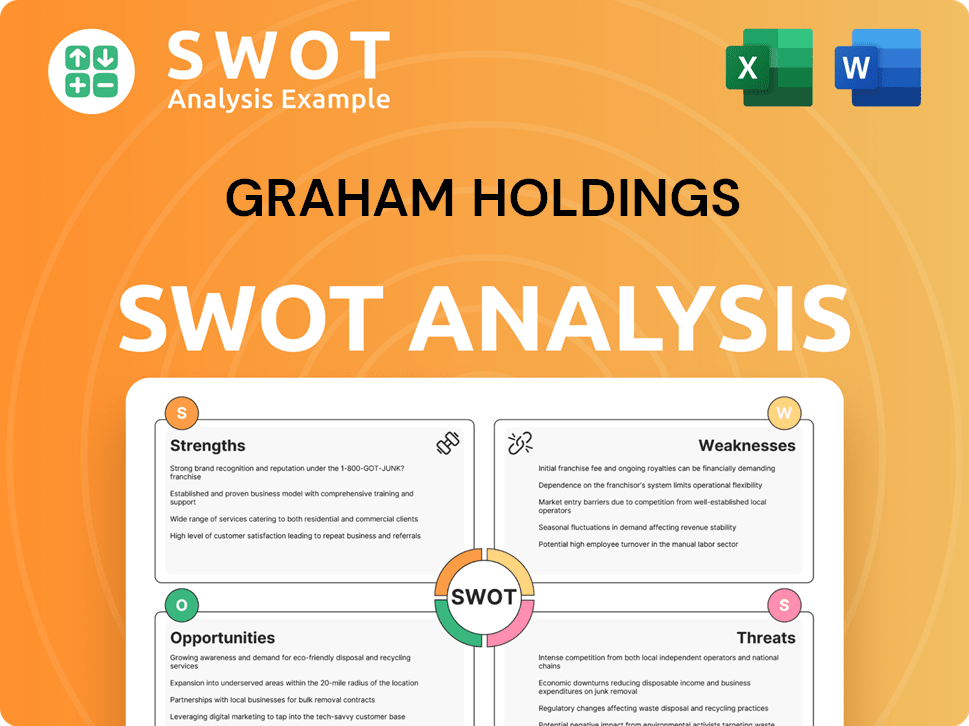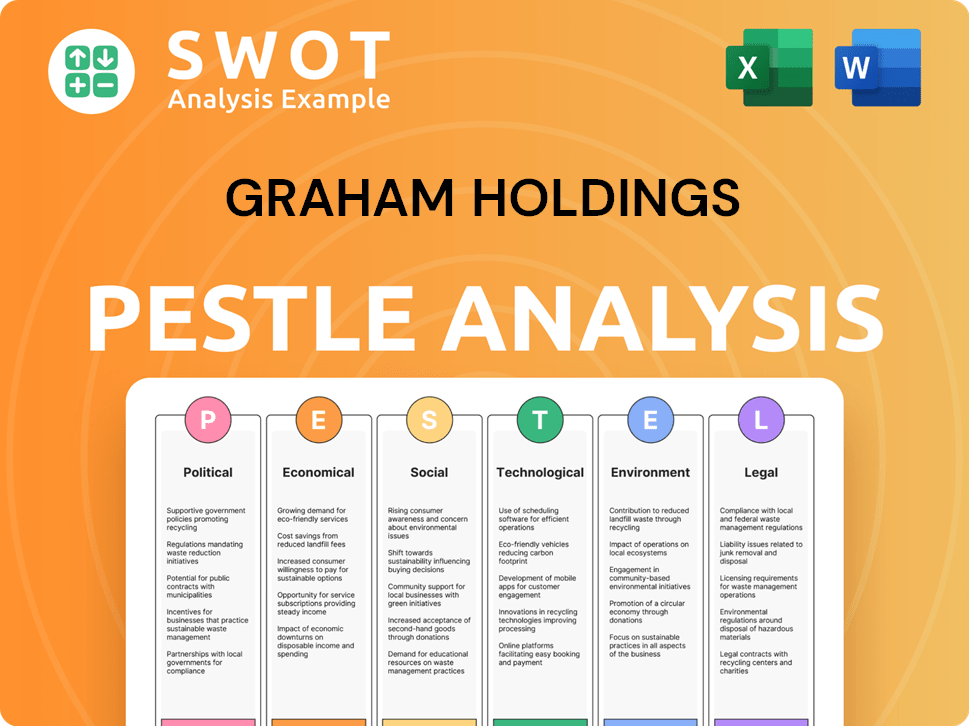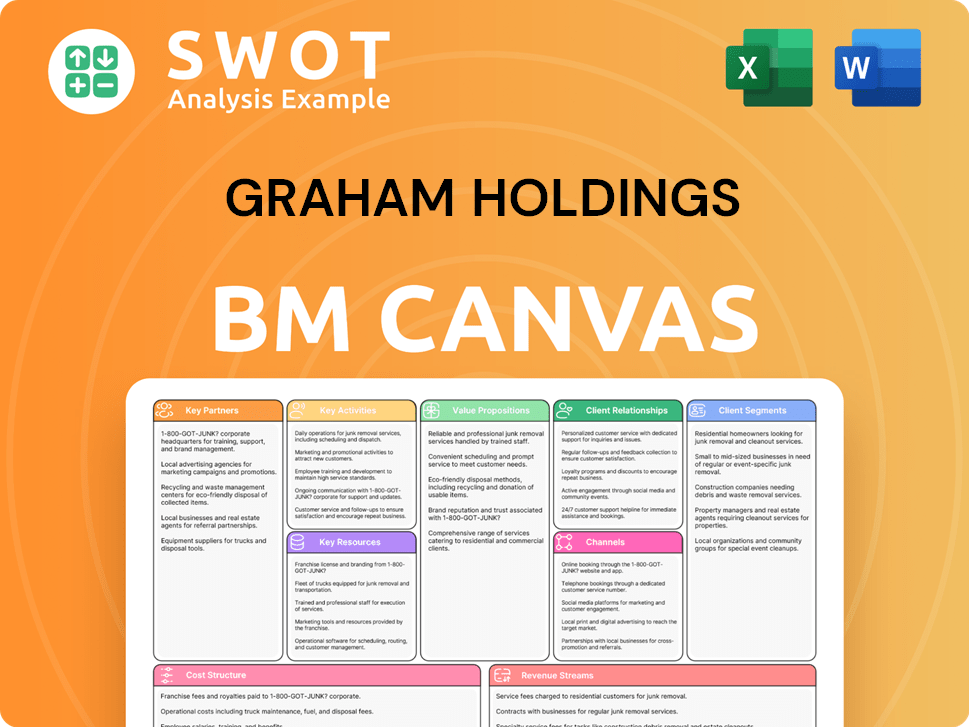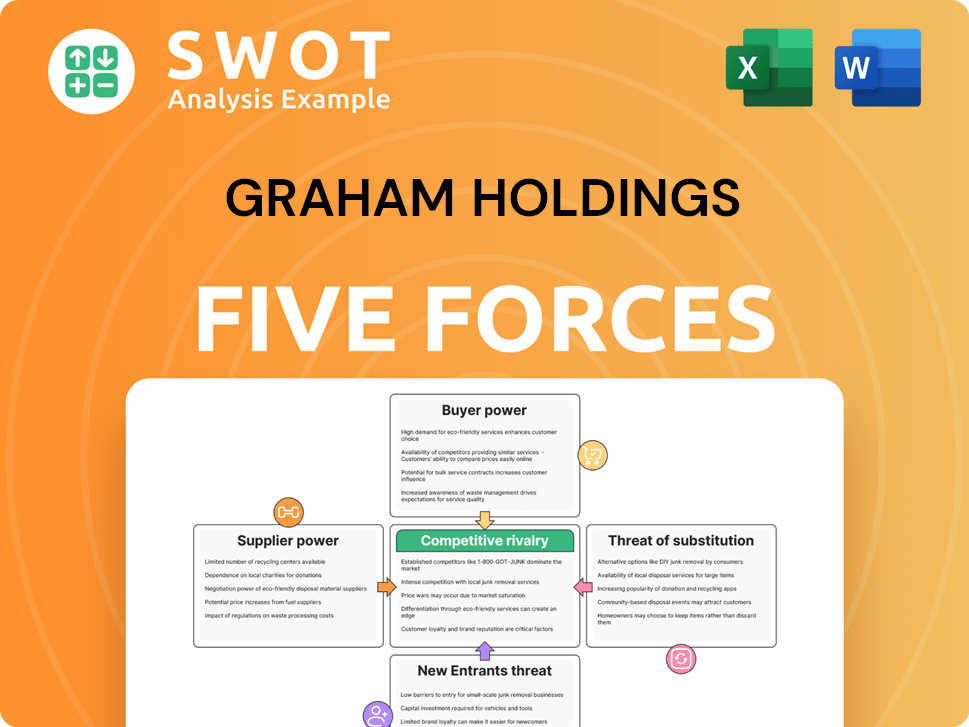Graham Holdings Bundle
How has the Graham Holdings Company transformed over time?
Journey back in time to explore the fascinating brief history of Graham Holdings, a company that has dramatically shifted its focus. From its roots in American journalism, deeply intertwined with the Washington Post, to its current diverse portfolio, the story of Graham Holdings Company is one of constant evolution. Discover how strategic decisions shaped this media giant into a multifaceted entity.

The Graham Holdings history demonstrates a remarkable ability to adapt and thrive. Initially known for media and information dissemination, the company, formerly known as the Post Company, has navigated economic shifts and technological advancements. Its evolution, including the acquisition of Kaplan Inc., showcases a commitment to value creation and strategic repositioning, solidifying its position in the market.
What is the Graham Holdings Founding Story?
The story of Graham Holdings Company, a diversified media and education company, begins with the founding of The Washington Post. This brief history of Graham Holdings is a journey through media, education, and strategic business decisions. The company's evolution reflects the changing landscape of American business and media.
The roots of Graham Holdings Company go back to 1877, when Stilson Hutchins established The Washington Post. Though not initially known as Graham Holdings, this newspaper was the cornerstone upon which the future company would be built. Hutchins's goal was to provide a comprehensive daily newspaper for the nation's capital, focusing on both news and advertising revenue.
A pivotal moment occurred in 1933 when Eugene Meyer acquired The Washington Post at a bankruptcy auction. Meyer, a financier, purchased the struggling newspaper for $825,000. This acquisition marked the beginning of the family's involvement, which would eventually lead to the formation of Graham Holdings Company. Meyer aimed to restore the paper's journalistic integrity and financial health. His daughter, Katharine Graham, and her husband, Philip Graham, later played crucial roles in the company's expansion and diversification.
Graham Holdings Company's early history is closely tied to The Washington Post.
- Stilson Hutchins founded The Washington Post in 1877.
- Eugene Meyer acquired The Washington Post in 1933 for $825,000.
- Katharine Graham and Philip Graham were key figures in the company's growth.
- The company’s initial focus was on newspaper publishing.
The original business model of The Washington Post revolved around subscriptions and advertising. The initial funding for Meyer's acquisition came from his personal wealth. Over time, the company expanded beyond newspaper publishing. The Post Company, as it was then known, diversified its holdings, eventually leading to the formation of Graham Holdings Company. The company's strategic decisions, including acquisitions and divestitures, have shaped its current structure. The company's evolution demonstrates its ability to adapt to changes in the media and education sectors. For more insights into the company’s strategic approach, consider reading about the Marketing Strategy of Graham Holdings.
Graham Holdings SWOT Analysis
- Complete SWOT Breakdown
- Fully Customizable
- Editable in Excel & Word
- Professional Formatting
- Investor-Ready Format

What Drove the Early Growth of Graham Holdings?
The early years of the Graham Holdings Company saw significant growth and diversification following the acquisition by Eugene Meyer. Under the leadership of Philip Graham, the company expanded its media holdings, venturing beyond print. This strategic move laid the groundwork for its future as a diversified company. Understanding the Revenue Streams & Business Model of Graham Holdings helps to understand its evolution.
The company's early expansion included acquisitions in the broadcasting industry. A key move was the 1946 acquisition of WTOP radio and television in Washington, D.C. This marked a crucial step into the burgeoning broadcasting sector. This early diversification set the stage for the Graham Holdings history.
After Philip Graham's passing in 1963, Katharine Graham took over, navigating the company through challenging times. Her leadership was pivotal during the Pentagon Papers and Watergate scandals. This period solidified the company's position as a major media conglomerate, influencing the Washington Post's legacy.
The company officially became Graham Holdings Company in 1997, reflecting its diversified portfolio. This shift included significant investments in educational services. The acquisition of Kaplan, Inc. in 1984 was a strategic move towards services.
In 2023, Graham Holdings Company reported revenues of $4.1 billion, demonstrating continued growth. This financial performance highlights the success of its diversified revenue streams. This reflects the evolution of the Post Company into a multifaceted enterprise.
Graham Holdings PESTLE Analysis
- Covers All 6 PESTLE Categories
- No Research Needed – Save Hours of Work
- Built by Experts, Trusted by Consultants
- Instant Download, Ready to Use
- 100% Editable, Fully Customizable

What are the key Milestones in Graham Holdings history?
Throughout its history, Graham Holdings Company has achieved several significant milestones. These achievements reflect its adaptability and strategic vision in navigating the evolving business landscape. The brief history Graham Holdings showcases a commitment to diversification and growth.
| Year | Milestone |
|---|---|
| Early Years | The company expanded beyond its initial newspaper holdings, demonstrating early diversification. |
| 1984 | Acquisition of Kaplan, Inc., marking a significant move into the education sector. |
| 2013 | Sale of The Washington Post to Jeff Bezos, reshaping the company's focus. |
| Recent Years | Expansion of Graham Healthcare Group services, reflecting growth in healthcare. |
One of Graham Holdings Company's significant innovations was its early adoption of television broadcasting, which diversified its revenue streams. This strategic move allowed the company to adapt to changes in the media industry.
The company moved beyond its newspaper roots by embracing television broadcasting.
The acquisition of Kaplan, Inc. in 1984 demonstrated foresight in identifying new growth sectors.
The company has faced challenges, including the decline in traditional newspaper advertising revenue. The rise of digital media also posed a threat to its core business. The sale of The Washington Post in 2013 was a strategic response to these challenges, allowing the company to focus on other growing segments.
The decline of traditional newspaper advertising and the rise of digital media presented significant challenges.
The sale of The Washington Post in 2013 was a major strategic decision.
Graham Holdings Business Model Canvas
- Complete 9-Block Business Model Canvas
- Effortlessly Communicate Your Business Strategy
- Investor-Ready BMC Format
- 100% Editable and Customizable
- Clear and Structured Layout

What is the Timeline of Key Events for Graham Holdings?
The brief history of Graham Holdings Company is a story of adaptation and expansion, starting with its roots in the newspaper industry. The company, originally known for publishing The Washington Post, has evolved into a diversified enterprise with interests in education, television broadcasting, manufacturing, and healthcare. Key milestones mark its transition from a media-focused business to a multifaceted holding company.
| Year | Key Event |
|---|---|
| 1877 | The Washington Post newspaper is founded by Stilson Hutchins, marking the beginning of the company's journey. |
| 1933 | Eugene Meyer purchases The Washington Post at a bankruptcy auction, beginning the family's ownership of the newspaper. |
| 1946 | Philip Graham becomes publisher, and the company begins expanding into radio and television broadcasting. |
| 1963 | Katharine Graham assumes leadership of The Washington Post Company, steering the company through significant changes. |
| 1984 | The company diversifies by acquiring Kaplan, Inc., a major move into educational services. |
| 1997 | The Washington Post Company officially renames itself Graham Holdings Company, reflecting its broader business portfolio. |
| 2013 | Graham Holdings Company sells The Washington Post newspaper to Jeff Bezos, reshaping its media presence. |
| 2023 | Graham Holdings Company reports annual revenues of $4.1 billion, highlighting its financial performance. |
Kaplan, Inc., a key part of Graham Holdings Company, is expected to continue expanding its educational offerings. This includes online courses, professional training, and higher education programs. The demand for accessible and flexible education is driving growth in this sector. Graham Holdings is likely to invest further in Kaplan to capitalize on these trends.
The healthcare sector is another area of focus for Graham Holdings. Graham Healthcare Group's acquisition in early 2024 indicates a commitment to expanding its healthcare services. The company is likely to explore further acquisitions and organic growth opportunities in this sector. The increasing demand for specialized healthcare services supports this strategy.
Graham Holdings Company is focusing on strategic initiatives within its existing segments, such as expanding Kaplan's educational offerings. The company's leadership emphasizes a commitment to long-term value creation. This includes prudent capital allocation and organic growth within its diverse businesses, ensuring sustained financial performance.
The company's ability to adapt and innovate has been a hallmark of its history. From its beginnings with the Washington Post to its current diversified portfolio, Graham Holdings has shown a capacity to evolve. This adaptability is expected to continue, with the company balancing established businesses with new ventures.
Graham Holdings Porter's Five Forces Analysis
- Covers All 5 Competitive Forces in Detail
- Structured for Consultants, Students, and Founders
- 100% Editable in Microsoft Word & Excel
- Instant Digital Download – Use Immediately
- Compatible with Mac & PC – Fully Unlocked

Related Blogs
- What is Competitive Landscape of Graham Holdings Company?
- What is Growth Strategy and Future Prospects of Graham Holdings Company?
- How Does Graham Holdings Company Work?
- What is Sales and Marketing Strategy of Graham Holdings Company?
- What is Brief History of Graham Holdings Company?
- Who Owns Graham Holdings Company?
- What is Customer Demographics and Target Market of Graham Holdings Company?
Disclaimer
All information, articles, and product details provided on this website are for general informational and educational purposes only. We do not claim any ownership over, nor do we intend to infringe upon, any trademarks, copyrights, logos, brand names, or other intellectual property mentioned or depicted on this site. Such intellectual property remains the property of its respective owners, and any references here are made solely for identification or informational purposes, without implying any affiliation, endorsement, or partnership.
We make no representations or warranties, express or implied, regarding the accuracy, completeness, or suitability of any content or products presented. Nothing on this website should be construed as legal, tax, investment, financial, medical, or other professional advice. In addition, no part of this site—including articles or product references—constitutes a solicitation, recommendation, endorsement, advertisement, or offer to buy or sell any securities, franchises, or other financial instruments, particularly in jurisdictions where such activity would be unlawful.
All content is of a general nature and may not address the specific circumstances of any individual or entity. It is not a substitute for professional advice or services. Any actions you take based on the information provided here are strictly at your own risk. You accept full responsibility for any decisions or outcomes arising from your use of this website and agree to release us from any liability in connection with your use of, or reliance upon, the content or products found herein.